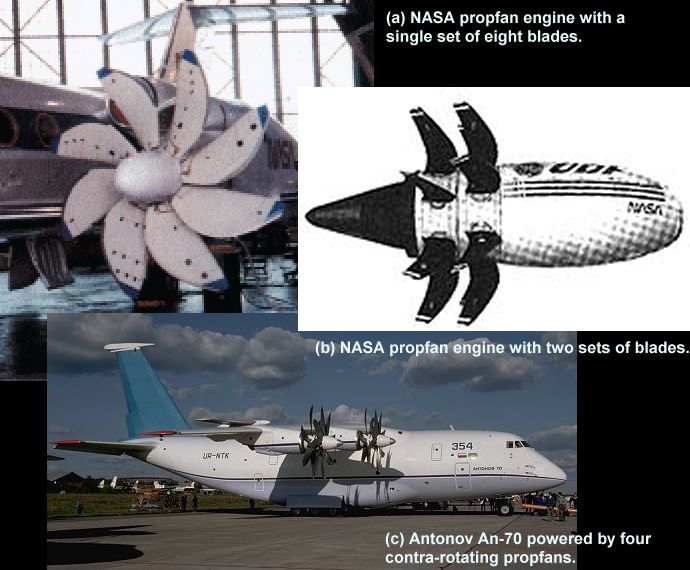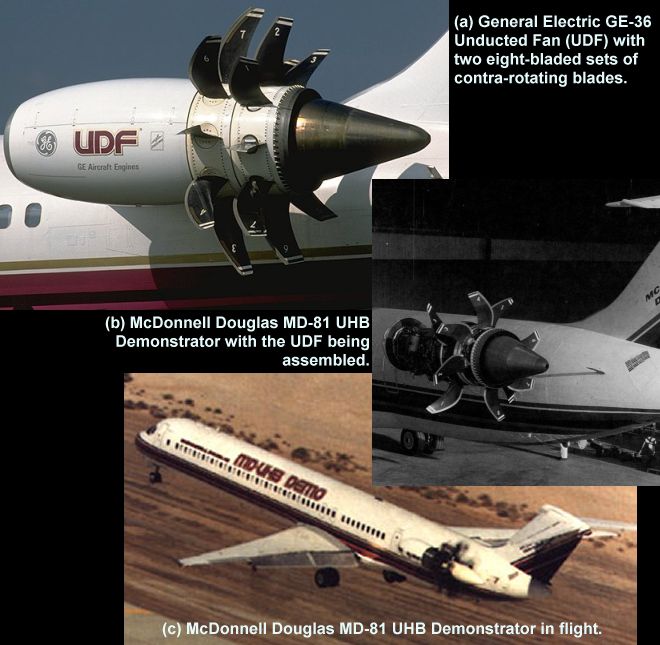|
||||||||||
|
|
||||||||||
|
||||||||||
|
|
||||||||||
However, I suspect that you may have seen something more unusual since it sounds like the engines on each side of the plane were different. Perhaps what you might have seen was an experimental propfan aircraft. A propfan is similar to a turbofan, or turboprop, in that it is powered by a jet engine core. Like the turbofan, the small jet core rotates at least one set of fan blades (often two or three), and these fans produce the majority of the thrust. However, the fans on a turbofan engine are contained within the engine nacelle ducting while those on a propfan are external like the propeller of a turboprop. It is for this reason that propfans are sometimes called unducted fans. Examples of propfan engines are shown below.

Perhaps one of the most significant series of propfan studies was conducted during the late 1970s and early 1980s. This effort culminated in flight tests of the McDonnell Douglas MD-UHB Demo aircraft based on the MD-81 airframe. The MD-UHB was used to evaluate advanced, experimental propulsion technologies designed to offer airlines significant improvements in fuel efficiency and lower operational costs.

The primary purpose of the technology demonstrator was to test the Pratt & Whitney-Allison 578-DX propfan and the General Electric GE-36 Unducted Fan (UDF) engines. Though initial research results looked promising, the drop in oil prices of the early 1980s resulted in weak interest from the airlines, and further development of the concept was largely ended.
However, propfan research has continued under the direction of NASA in the United States and other research institutions in Europe and Russia throughout the 1990s. Because these engines offer significant improvements in fuel efficiency, they have been seriously considered by a number of aircraft manufacturers. Only Antonov in Ukraine has gone so far as to incorporate propfans into a production aircraft called the An-70, but several other manufacturers may follow suit. The propfan may be particularly attractive to the commuter aircraft market.
Several planes used to test propfan engines have been designed to carry the propfan on one side of the aircraft
while retaining a conventional jet engine on the other. This configuration was used on the MD-UHB demo as well
as other testbeds like a Boeing 727 and Yakovlev Yak-42. A similar
case was a Gulfstream II modified for tests by Lockheed and NASA that retained the standard twinjet layout on the
aft fuselage but added a propfan on the starboard wing. These configurations allow the plane to remain powered
using conventional, reliable engines in case the experimental propfan were to fail in flight.
- answer by Jeff Scott, 24 February 2002
Related Topics:
Read More Articles:


|
Aircraft | Design | Ask Us | Shop | Search |

|
|
| About Us | Contact Us | Copyright © 1997-2023 | |||
|
|
|||